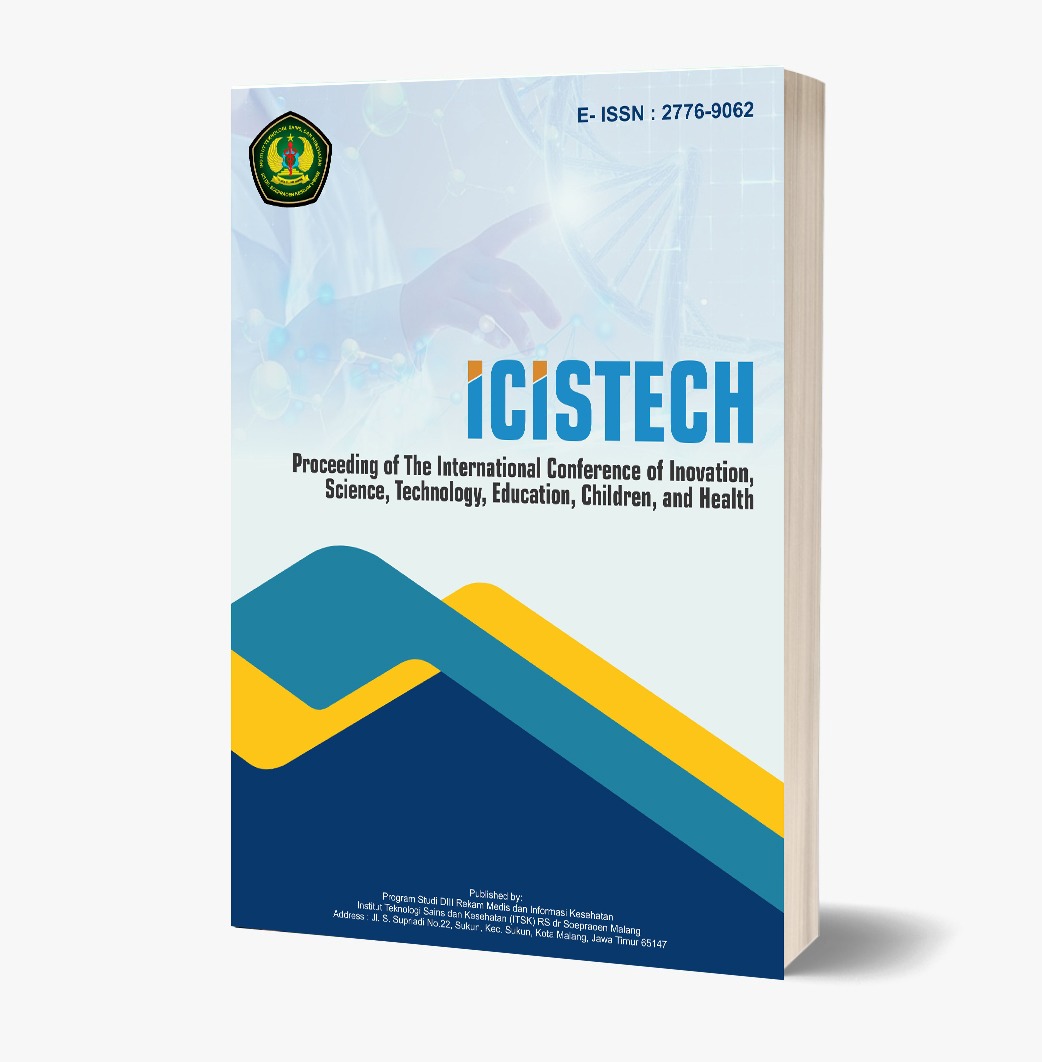Icistech Literature Review: Fatty Acid Therapy Of Butternut Squash Seed Extract (Cucurbita Moschata Duchesnes) On Healing Of Type 2 Diabetes Mellitus Wounds
Keywords:
fatty acids, butternut squash seed, type 2 diabetes mellitus, wound healingAbstract
Background, prevalence of diabetes mellitus (DM) has increased from year to year, the disease has characteristics of increased blood sugar levels, caused by insulin resistance and the inability of the pancreas to secrete insulin. DM can increase the risk of chronic hyperglycemia which results in DM complications in the form of wounds on the feet. Treatment of wound healing due to DM with butternut squash seed (Cucurbita moschata Duchesnes) contains fatty acids including: linoleic, oleic, lauric, and palmitic. The purpose of the review is to determine the effect of butternut squash seed extract (Cucurbita moschata Duchesnes) fatty acid therapy on healing type 2 diabetes mellitus wounds. The review method uses a narrative review method through literature searches, identification, searching, and downloading national and international journal references. Literature studies are conducted through several portals, such as Pubmed, Elseviewer, ScienceDirect, and Google Scholar. The references that have been found are in accordance with the inclusion criteria that have been set. Articles are not used if the topic is not relevant. Reference search in the form of research journals published on the internet in the last 10 years from 2014-2024. Results and discussion, fatty acids in butternut squash seeds have the potential for better wound healing. It is known that fatty acids can change the structure and immunology of the skin because they function as the stratum corneum and can change skin permeability. Fatty acids also inhibit proinflammatory eicosanoids, reactive species (ROS and RNS), and cytokines, thereby affecting inflammation and causing wound healing. Conclusion: therapy with fatty acids in butternut squash seed extract (Cucurbita moschata Duchesnes) can cause healing of type 2 diabetes mellitus wounds.
References
Abbas, N. F., & Alrekabi, F. M. K. (2018). The role of pumpkin seed oil in healing of wounds in diabetic mice. Indian Journal of Natural Sciences, 8(47), 13604-13614.
Alexander, J. W., & Supp, D. M. (2014). Role of arginine and omega-3 fatty acids in wound healing and infection. Advances in Wound Care, 3(11), 682-690.
Al-Hadi, H., & Zurriyani, A. S. (2020). Prevalensi diabetes melitus tipe 2 dengan kejadian hipertensi di Poliklinik Penyakit Dalam RS Pertamedika Ummi Rosnati. Jurnal Medika Malahayati, 4(4), 291-297.
Amin, M., Niaz, S., Sardar, S., Hussain, A., Korani, M. A., Burhan, M., et al. (2023). A novel study of pumpkin (Cucurbita moschata) on morphology and its yield attributing characters in Pakistan. Journal of Population Therapeutics, 30(17), 992-1000.
Andrejiova, A., Hegedusova, A., Matova, A., & Vargona, A. (2018). The possibility of butternut squash growing in conditions of Slovak Republic. International Journal of Agriculture, Forestry and Life Science, 2(2), 116-121.
Artha, I. M. J. R., Bhargah, A., Dharmawan, N. K., Pande, U. W., Triyana, K. A., Mahariski, P. A., et al. (2019). High level of individual lipid profile and lipid ratio as a predictive marker of poor glycemic control in type-2 diabetes mellitus. Vascular Health and Risk Management, 15, 149-157.
Baltziz, D., Eleftheriadou, I., & Veves, A. (2014). Pathogenesis and treatment of impaired wound healing in diabetes mellitus: New insights. Advances in Therapy, 31
Bardaa, S., Halima, N. B., Aloui, F., Mansour, R. B., Jabeour, H., Bouaziz, M., & Sahnoun, Z. (2016). Oil from pumpkin (Cucurbita pepo L.) seeds: Evaluation of its functional properties on wound healing in rats. Lipid in Health and Disease, 15(73), 2-12.
Dasari, N., Jiang, A., Skochdopole, A., Chung, J., Reece, E. D., Vorstenbosch, J., & Winocour, S. (2021). Updates in diabetic wound healing, inflammation, and scarring. Seminars in Plastic Surgery, 35(3), 153-158.
Deng, H., Li, B., Shen, Q., Zhang, C., Kuang, L., Chen, R., Wang, S., Ma, Z., & Li, G. (2023). Mechanisms of diabetic foot ulceration: A review. Journal of Diabetes, 15(4), 299-312.
Ezin, V., Gbemenou, U. H., & Ahanchede, A. (2022). Characterization of cultivated pumpkin (Cucurbita moschata Duchesne) landraces for genotypic variance, heritability and agro-morphological traits. Saudi Journal of Biological Sciences, 29(5), 3661-3674.
Gbemenou, U. H., Ezin, V., & Ahanchede, A. (2022). Current state of knowledge on the potential and production of Cucurbita moschata (pumpkin) in Africa: A review. African Journal of Plant Science, 16(1), 8-21.
Genser, L., Rossario, J., Mariolo, C., Castagneto-Gissey, L., & Panagiotopoulos, S. (2016). Pathophysiologic relationships and guidelines for surgical intervention. Surgical Clinics of North America, 96(4), 681-701.
Hariono, M., Yuliani, S. H., Istyastono, E. P., Riswanto, F. D. O., & Adhipandito, C. F. (2018). Matrix metalloproteinase 9 (MMP9) in wound healing of diabetic foot ulcer: Molecular target and structure-based drug design. Wound Medicine, 22(1), 1-13.
Kim, J. (2023). The pathophysiology of diabetic foot: A narrative review. Journal of Yeungnam Medical Science, 40(4), 328-334.
Kim, K. A., Shin, Y. J., Kim, J. H., Lee, H., Noh, S. Y., Jang, S. H., & Bae, O. K. (2012). Dysfunction of endothelial progenitor cells under diabetic conditions and its underlying mechanisms. Archives of Pharmacal Research, 35(2), 223-234.
Mariadoss, A. V. A., Sivakumar, A. S., Lee, C., & Kim, S. J. (2022). Diabetes mellitus and diabetic foot ulcer: Etiology, biochemical and molecular based treatment strategies via gene and nanotherapy. Biomedicine & Pharmacotherapy, 151(1), 1-14.
Mariamenatu, A. H., & Abdu, E. M. (2021). Overconsumption of omega-6 polyunsaturated fatty acids (PUFAs) versus deficiency of omega-3 PUFAs in modern-day diets: The disturbing factor for their "balanced antagonistic metabolic functions" in the human body. Journal of Lipids, 1-15.
Mieczkowski, M., Rakowska, B. M., Kowara, M., Kleibert, M., & Czupryniak, L. (2022). The problem of wound healing in diabetes: From molecular pathways to the design of an animal model. International Journal of Molecular Sciences, 23(14), 1-21.
Nopianasanti, H., & Setiadi Daryono, B. (2018). Kestabilan fenotip tanaman labu susu (Cucurbita moschata (Duchesne) Poir “Butternut”) hasil budidaya di Sleman D.I Yogyakarta. Biogenesis: Jurnal Ilmiah Biologi, 6(2), 115-123.
Nurlian, S., Jafar, N., & Arman. (2024). Pengaruh pemberian ekstrak daun tembelekan (Lantana camara L.) terhadap penyembuhan luka diabetes melitus. Bina Generasi: Jurnal Kesehatan, 15(2), 41-51.
Okonkwo, U. A., & Dipietro, L. A. (2017). Diabetes and wound angiogenesis. International Journal of Molecular Sciences, 18(7), 1419.
Prayugo, B., Ikhwan, M., & Yamamoto, Z. (2021). Potensi ekstrak ikan gabus terhadap kesembuhan luka diabetes. Jurnal Kedokteran Syiah Kuala, 21(2), 172-183.
Purnomo, Daryono, B. S., & Sentori, M. B. (2015). Variability and intraspecies classification of pumpkin (Cucurbita moschata (Duch. ex Lam.) Duch. ex Poir.) based on morphological characters. KnE Life Sciences, 2(1), 286-293.
Putri, N. R. A., Kusnanda, P. S., Angellya, B. F., Sartika, D., & Purnomo, Daryono, B. S. (2023). Genetic variation of butternut squash (Cucurbita moschata Duchesne) based on inter-simple sequence repeat. Journal of Tropical Biodiversity and Biotechnology, 8(1), 1-8.
Rodrigues, H. G., Vinolo, M. A. R., Sato, F. T., et al. (2016). Oral administration of linoleic acid induces new vessel formation and improves skin wound healing in diabetic rats. PloS One, 1-19.
Rustan, A. C., & Drevon, C. A. (2005). Fatty acids: Structures and properties. Encyclopedia of Life Sciences, 1-7.
Sativa, A. R. (2019). Mekanisme diabetes melitus tipe 2 dalam meningkatkan risiko penyakit katarak. Jurnal Ilmu Kedokteran dan Kesehatan, 6(2), 160-165.
Shaban, A., & Sahu, R. P. (2017). Pumpkin seed oil: An alternative medicine. International Journal of Pharmacognosy and Phytochemical Research, 9(2), 2-8.
Silva, J. R., Burger, B., Kuhl, C. M. C., Candreva, T., Anjos, M. B. P., & Rodrigues, H. G. (2018). Wound healing and omega-6 fatty acids: From inflammation to repair. Mediators of Inflammation, 1-17.
Downloads
Published
How to Cite
Issue
Section
License
Copyright (c) 2024 Proceeding of The International Conference of Inovation, Science, Technology, Education, Children, and Health

This work is licensed under a Creative Commons Attribution-ShareAlike 4.0 International License.















